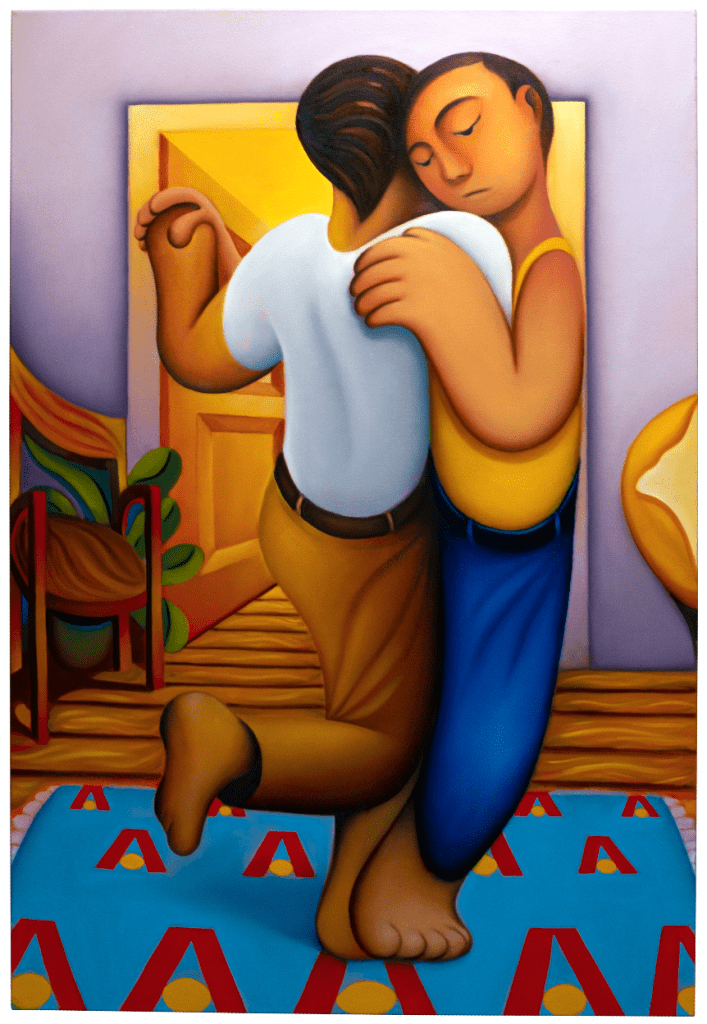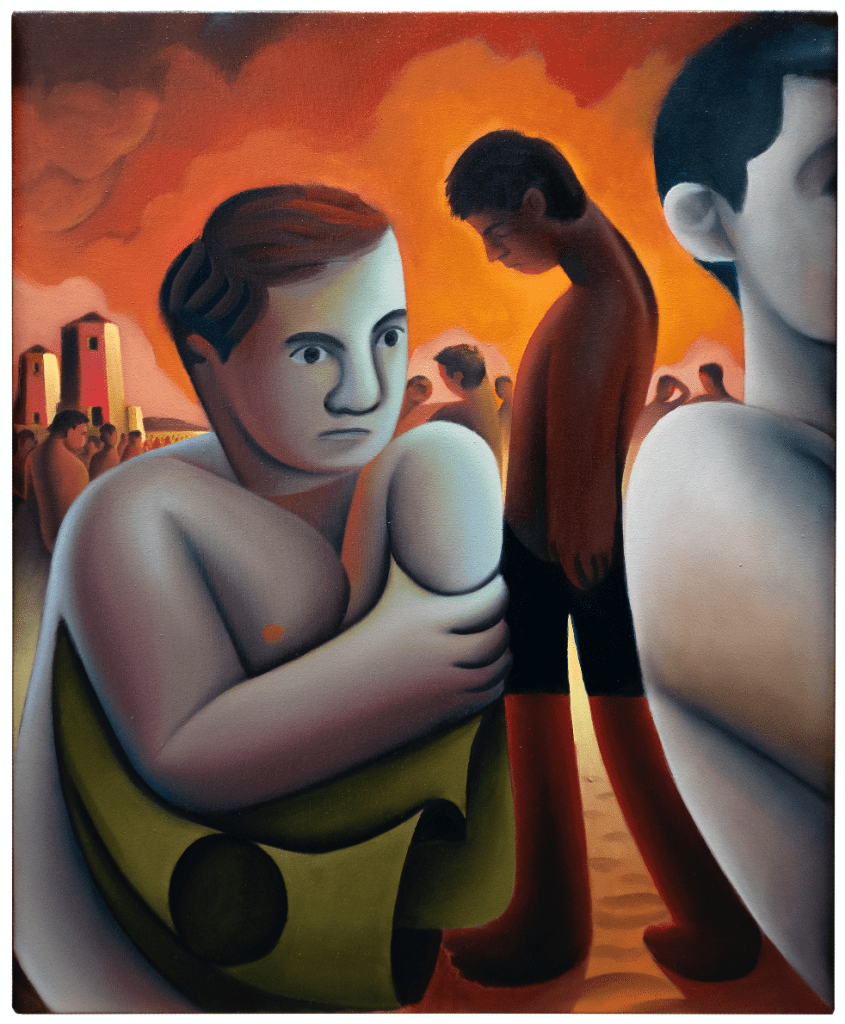Brooklyn based painter Justin O’Brien will move you into a colorful experience of intimacy and loneliness. Having recently removed himself from his day job, O’Brien has become solely dedicated to his work. The result is a profound analysis of isolation as an all-too common feeling in the last year. The paintings are filled with juxtapositions of calm and anxiety, all beautifully entwined in expressive human figures. Read below to learn more about the artist, his fascinating artistic path, and his upcoming shows!

Learn to Swim, 2020, 60 x 72 in., Oil on Canvas, Courtesy of the Artist
Tell us a little bit about yourself. Where are you from and how did art first come into your life?
I was born in Flushing, Queens in 1991. We moved out to eastern Long Island in 1996 to live with my grandparents after my father passed away. I first remember making “art” with my mom’s friend Claudia Nostrand, a musician and a painter. She was a true bohemian. Claudia and her three sisters lived on this huge tract of farmland where we would occasionally go to visit. I remember doodling with pencils and crayons in her kitchen. I was probably 7. I drew a nude woman that she liked and asked to keep. I felt really validated by that. I think I kept on looking for that sort of validation in making art as a kid. To be honest, I probably still am now.

Julius’, 2020, 54 x 40 in., Oil on Canvas, Courtesy of the Artist
Has your work always taken on the style it currently embodies?
It’s rather new. After I graduated from Pratt I started to make paintings with some figurative elements. They had what I thought was a “computerized” look to them, some weird bridge between fine art and digital art. I was looking at Leger and Diego Rivera a lot then and trying to riff on that simplicity. Then I started using the figure in a narrative way. Putting them in rooms and spaces. Even to paint explicitly about my own life and relationships. I think that’s about where the style is now.

Bread on a Seder Plate, 2020, Oil on Canvas, 48 x 36 in., Courtesy of the Artist
What is your process like? How do you begin a work?
I begin by making several drawings. They might reference a photograph, a subject in life or be from imagination. I’ll iterate on a drawing a few times and put it on the wall in my studio. Then I do a wash of it on a canvas. Over four or five sessions with the painting it will hopefully be done. Sometimes I’m not so lucky and it takes much longer. The trouble is the drying time between these sessions. A layer of paint with the standard oil medium I use to dilute it might take a full week to dry.

Blue Rug Under After Steers, 2020, Oil on Canvas, 60 x 40 in., Courtesy of the Artist
Walk us through a day in the studio.
Now that I’ve left my day job and I keep regular studio hours. I get to my studio between 9 and 10am, which is in walking distance from my apartment. I will normally stop for coffee or fruit to snack on. Depending on the day I might linger at home to work on drawings or answer emails. I paint until 6 or 7pm then go home.

Michael and Marcelo After Ian Lewnadowski, 2020, Oil on Canvas, 60 x 40 in., Courtesy of the Artist
From where do you draw inspiration?
I look at baroque painting very often. Velasquez and Rubens. I think about Caravaggio all the time. Lately I’ve been thinking about Otto Dix and Thomas Hart-Benton’s war paintings. A recent discovery for me. Always trying to see more.

Leaving Riis, 2020, Oil on Canvas, 30 x 24 in., Courtesy of the Artist
What larger questions do you think your work asks?
The two main ones are: “Why am I lonely if I’m not alone?” and “Why am I worried if everything is alright?”. These feel core to the work at present. The paintings should ooze these questions!

One of Us Must Die, 2020, Oil on Canvas, 60 x 48 in., Courtesy of the Artist
Tell us about the fluid figurative style in your compositions. How did that style come to be?
The fluid figures started appearing in my work around 2017. I mentioned I had been experimenting with painting things to look computer-generated after graduating from Pratt’s digital arts program the year prior. Also, I had recently come out. It felt like there was something deeply artificial to being young, gay and single in New York City. I met everyone through some dating app or Instagram which was confusing and incongruous to what I imagined gay city life would be. I thought if I made paintings about queer affection or social isolation in this digital-ish style it might neatly frame this problem for me. After I did a few of these paintings I started to realize those fluid figures weren’t as digital looking as they were more like forms in Leger, Diego Rivera or George Tooker. I’ve been trying to lean into that ever since.

Between Supposed Lovers, 2020, Oil on Canvas, 60 x 60 in., Courtesy of the Artist
What’s next for you?
Right now I’m finishing work for a group show at Monya Rowe Gallery with Aubrey Levinthal and Polina Barskaya called Me, Myself, and I opening January 14th.

Colin, NOLA, 2020, Oil on Canvas, 20 x 16 in., Courtesy of the Artist
At the end of each interview, we like to ask the artist to recommend a friend whose work you love and would like us to interview next. Who would you suggest?
I think Emily Marie Miller would be perfect for this! She’s making a solo show at Monya Rowe Gallery opening 4/2021.